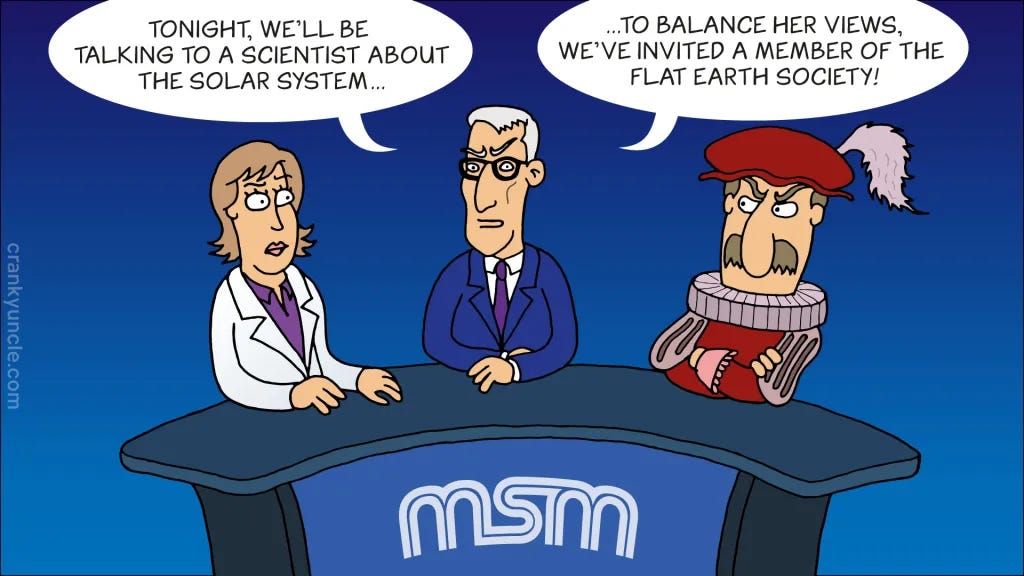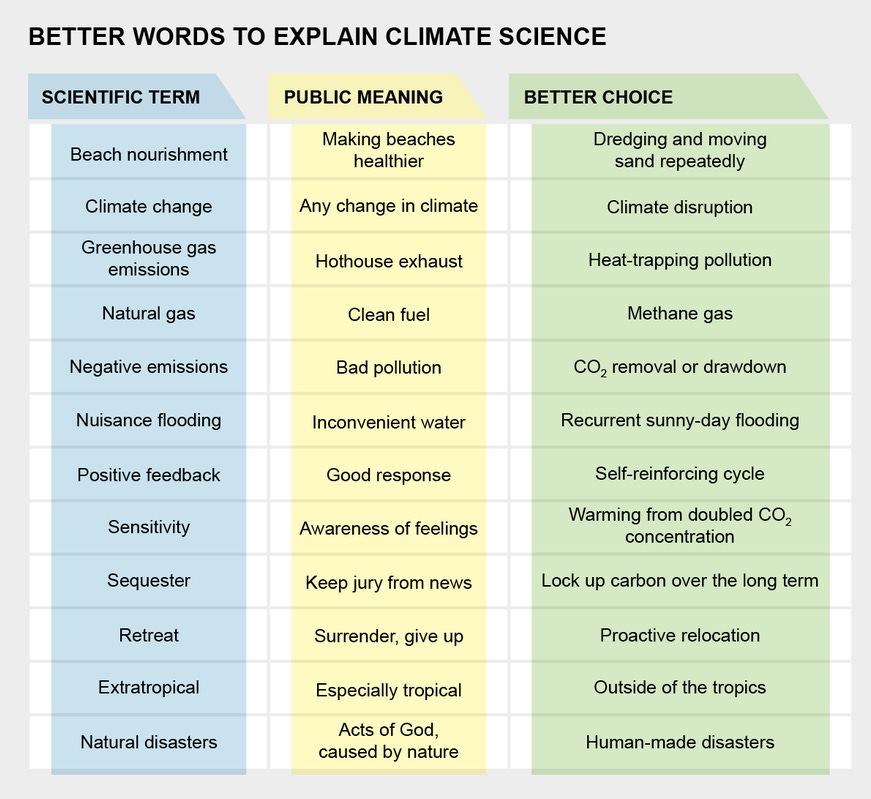Ever heard of “false balance” media coverage?
It’s a “classic” climate communication challenge.
In this week’s edition of Terreminder, we’ll take a closer look at it.
But first, the news:
Transition Tracker
Selected stories, news, and commentaries on the Green Transition.
Achilles’ steel: Renewable energy heavily relies on “dirty” steel. Time to change that.
Everything is politics, dude: This study suggests political identities might have a much stronger effect on climate denial than previously thought.
Down under(performing: A look into Australia’s climate adaptation struggle.
Arctic climate data collection has frozen: There are a billion reasons for why war sucks. Here’s one more.
Who will get the money - and when?: Analyzing the planned loss-and-damage fund.
More money, less problems: How Asia can unlock $800 billion of climate financing.
Visual learner? Here you go: The New York Times just posted 30 insightful graphs on climate change.
Time to slide-tackle climate change: “Football needs to stand up for climate change,” argues this former football star.
Au revoir, insurance: Around 2,000 French cities and towns are yet another example for how climate change is bringing our insurance system to its knees.
And now, off (balance) we go.
What exactly is false balance?
False balance, sometimes called bothsidesism, is when a report suggests that two sides have equally valid arguments, even though the evidence weighs heavily in favour of one side.1
In the context of climate change, false balance occurs when media outlets provide a platform for climate denial or skepticism alongside established scientific evidence of anthropogenic global warming.
Where does false balance coverage come from?
Ironically, it stems from the journalist’s desire to cover a topic in a fair and impartial way. The (laudable) norm of “presenting both sides” of a story can perpetuate false balance, when one side lacks credibility.2
Climate Communication expert John Cook gives two more reasons:
The preference for adversarial formats: Media outlets often prefer short, spectacular and heated confrontations. They bring in more attention, more viewers, and more clicks. They simply sell better.
Fewer specialized journalists: Budget cuts have reduced the number of specialized journalists in recent years. As a consequence, more general journalists have been covering climate change. Many of them seem to have “exaggerated the level of scientific disagreement” due to confusion about fundamental climate science concepts.3
Why exactly is false balance a problem?
False balance can cause three main problems:4
1: doubt about the existence of the consensus
2: confusion about what’s true
3: a tendency to prefer the more comfortable option
“Psychology provides an indication that many people have a tendency to prefer a more placating option, that is if someone is arguing that climate change is not something to worry about, no matter how little evidence there is for this, some people will take the cognitive route that it is easier not to worry.”5
Another issue:
“Many people think anything they can easily recall is likely to be true. Hence, if false or misleading information is easier to grasp or has the winning soundbite, then people are more likely to recall it and think that it is ‘true’.”6
False balance undermines public understanding of climate change by presenting it as a matter of debate rather than scientific consensus. This can create confusion, apathy, and inaction. It also grants disproportionate attention to climate skeptics and deniers. By amplifying these voices, it can delay much-needed climate action.
Source/Credit: https://crankyuncle.com/cranky-uncle-cartoons/
In a way, false balance coverage gives the impression that the science is “uncertain” without ever mentioning the word.7
"Those who do not understand the scientific consensus about human-caused climate change are, in turn, less likely to believe that climate change is happening, human-caused, will have serious consequences, and is solvable (i.e., can be mitigated through concerted action). In addition, not understanding this scientific consensus undermines Americans' support for a broad societal response to the threat. As a result, knowledge of the scientific consensus on human-caused climate change can be considered a “gateway” cognition; as members of the general public come to understand the consensus, they more likely come to the conclusion that human-caused climate change is happening and harmful."8
Communicating the scientific consensus on climate change seems to not only increase public perception of the consensus, it also increases perceptions about climate change and support for action. This has been described as the Gateway Belief Model.9
How can we avoid false balance?
To prevent false balance in climate communication, media outlets and communicators must prioritize accuracy and always emphasize the overwhelming scientific evidence supporting human-caused global warming.
Fostering critical thinking skills and media literacy among the public can help discern credible information from misinformation.
To prevent false balance coverage, weight-of-evidence and weight-of-experts information are essential. It is possible to acknowledge multiple sides to the debate and still point out that one side is supported by overwhelming evidence and a scientific consensus.10
According to Inoculation Theory, exposing people to a “light” form of misinformation may strengthen their “cognitive immunity”, preventing actual misinformation from misleading them.11
It is also important to raise public awareness of certain rhetorical techniques and logical fallacies.
Some actionable advice:12
Are you tempted to say that two or more things are equal? Ask yourself: Can you really justify the statement?
If you’re using a potentially controversial comparison, explain why you think it is legit.
Test other people’s statements of equivalency before you accept or share them.
Make sure to reflect all sides of the argument and always explain why some arguments are questionable.
To many people, climate change is an abstract subject with seemingly little relevance to their daily lives. That’s why it is important to highlight how it can affect them - without using expert jargon. Questions like “I’m struggling with the cost of living as it is, so why should I prioritise something that isn’t impacting me right now?” demand concrete, straightforward answers.13
Is false balance still a problem?
Some experts argue that false balance is not a problem anymore:
“Climate denialism is dead as a news media phenomenon. (...) The era of false balance, where you used to have a scientist always balanced with a climate denier in news stories, is over.”14
While there has been progress, false balance remains an issue in the public discourse. Climate denialism and skepticism continue to be amplified by influential figures and interest groups, perpetuating misinformation and slowing down meaningful progress.
More recently, political polarization has become a growing problem for climate communication. Just imagine a meteorologist and climate reporter receiving death threats and having to move around with security guards…15
Several trends form a dangerous mix: The existential threat from climate change, the decline in trust in science and the media, the rise in disinformation, and the growth of far-right authoritarianism.16
“Trusted messengers” are needed to pierce the filter bubbles of climate deniers.17
Over time, misinformation efforts have evolved from denying climate change to delaying climate efforts. This approach has been labeled “delayist” instead of “denialist”.18
Which other challenges does climate communication face?
While false balance is less prevalent today, climate communication still struggles with many other challenges, including the sheer complexity of the issue, various psychological barriers, growing political polarization, and the problem of communicating uncertainty while also demanding action.
Some experts, most notably Susan Joy Hassol, demand that we change the language we use to cover climate change.19
For example, the public meaning of “positive feedback” is “a good response” while in Climate Science it refers to a self-reinforcing cycle causing temperatures to rise even further. This overview published in the Scientific American provides more examples:
Credit: Susan Joy Hassol, styled by Scientific American
It’s an approach worth considering when looking at Don’t look up-ish material like this:
“In 2021 researchers at Yale University found that Americans associate natural gas with “clean” and methane gas with “pollution”—even though natural gas is almost entirely methane.”20
Conclusion: Words matter!
Effective climate communication is crucial to raise awareness, mobilize action, and drive meaningful policy change. Addressing false balance and other communication challenges must be a top priority.
“Climate change is a great case study of the false balance problem, because the scientific consensus is nearly unanimous. If 99 doctors said you needed surgery to save your life, but one disagreed, chances are you’d listen to the 99” (...) “But we often see one climate scientist pitted against one climate denier or down player, as if it’s a 50-50 split.”21
It’s high time we move from “Does it exist or not?” to “How do we fix it?”.
Only then we’ll regain our balance.
P.S.: Old but cold (and gold):
That’s it for this week.
Hope you enjoyed the read. Thank you for your time.
If you like this newsletter, please consider sharing it with others.
See you next week!
Lennard
Sources
https://mediahelpingmedia.org/advanced/false-equivalence-and-false-balance/
https://crankyuncle.com/wp-content/uploads/2022/07/Cook_2022_false_balance.pdf
ibid.
https://news.northwestern.edu/stories/2022/07/false-balance-reporting-climate-change-crisis/
https://www.digitaljournal.com/tech-science/climate-change-and-the-fallacy-of-bothsidesism/article
ibid.
https://crankyuncle.com/wp-content/uploads/2022/07/Cook_2022_false_balance.pdf
https://www.theguardian.com/environment/climate-consensus-97-per-cent/2014/may/23/john-oliver-best-climate-debate-ever
https://crankyuncle.com/wp-content/uploads/2022/07/Cook_2022_false_balance.pdf
ibid.
ibid.
https://mediahelpingmedia.org/advanced/false-equivalence-and-false-balance/
https://www.harvard.co.uk/why-climate-change-is-the-biggest-comms-challenge-of-our-time/
https://allianceforscience.org/blog/2023/09/climate-misinformation-in-the-media-is-dead-new-alliance-for-science-study-finds/
https://www.voanews.com/a/press-freedom-climate-conspiracy-media-attacks/7273103.html
ibid.
ibid.
https://allianceforscience.org/wp-content/uploads/2023/09/Climate-Misinformation-Study-FINAL.pdf
https://www.scientificamerican.com/article/the-right-words-are-crucial-to-solving-climate-change/
ibid.
https://news.northwestern.edu/stories/2022/07/false-balance-reporting-climate-change-crisis/





